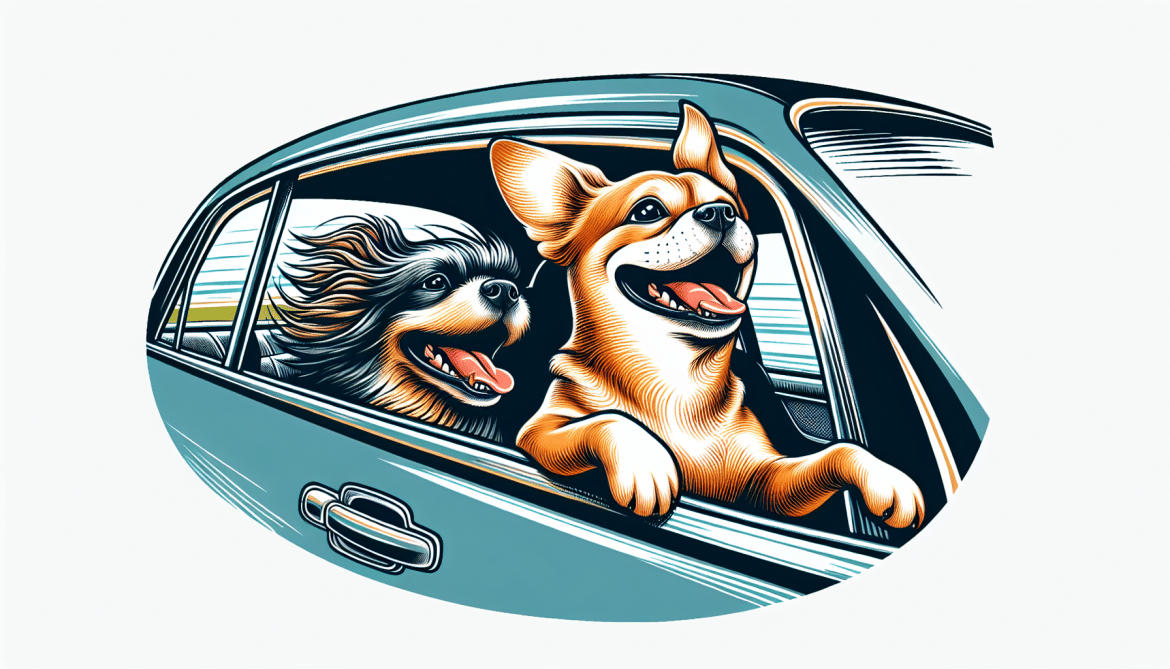Traveling with your furry friend can be an exciting and rewarding experience, but it can also come with its fair share of challenges. In this article, we will explore essential tips to ensure a smooth and enjoyable journey for both you and your dog. From planning ahead and ensuring their comfort to finding pet-friendly accommodations and maintaining proper safety measures, these guidelines will help you make the most out of your adventures together. So pack your bags and get ready for an unforgettable trip with your beloved canine companion!
Traveling with Your Dog: Tips for a Smooth Experience
Traveling with your dog can be an exciting and rewarding experience. Whether you're going on a weekend getaway or embarking on a longer journey, it's important to plan ahead and make preparations to ensure your dog's comfort, safety, and well-being throughout the trip. In this article, we will provide you with a comprehensive guide on how to prepare for your trip, choose the right mode of transportation, address health and safety considerations, ensure comfort during the journey, manage food and water, take breaks and exercise, provide proper identification, maintain discipline and control, navigate accommodations and destinations, and deal with travel anxiety. By following these tips, you can have a memorable and enjoyable trip with your furry friend.
Preparing for the Trip
Check with the airline or transportation mode
Before you embark on your journey, it's crucial to check with the airline or transportation mode regarding their pet policies and requirements. Different airlines and transportation options have varying rules and regulations when it comes to traveling with pets. Some may have restrictions on certain breeds or require specific documentation. By checking in advance, you can ensure a smooth and hassle-free experience at the airport or on other modes of transportation.
Get your dog accustomed to the carrier
If you plan to use a carrier to transport your dog, it's important to get them accustomed to it beforehand. Dogs may feel anxious or uncomfortable in unfamiliar environments, so gradually introducing them to the carrier can help alleviate stress. Start by leaving the carrier open in your home and encouraging your dog to explore it on their own. Gradually increase the amount of time your dog spends inside the carrier and offer rewards or treats to create positive associations.
Pack essential items for your dog
It's essential to pack all the necessary items to ensure your dog's comfort and well-being during the trip. Some essential items to consider include:
- Food and water bowls
- Leash and harness
- Bedding or a blanket for comfort
- Necessary medications and first-aid kit
- Toys or treats for entertainment
- Waste disposal bags
- Identification tags and copies of important documents, such as vaccination records
By packing these essential items, you can ensure that your dog has everything they need while away from home.
Choosing the Right Mode of Transportation
Consider your dog's temperament and size
When selecting the mode of transportation, consider your dog's temperament and size. Some dogs may feel more comfortable traveling in a car, while others may be more at ease on a plane or train. Additionally, large dog breeds may require different accommodations compared to smaller breeds. By considering your dog's individual needs, you can choose the transportation mode that is best suited for them.
Evaluate the travel duration
The duration of your trip is an important factor to consider when choosing the mode of transportation. Shorter trips may be more manageable in a car, while longer journeys may require air or rail travel. Take into account your dog's comfort, as well as any necessary breaks or rest stops during extended travel. Remember that your dog's well-being should always be a top priority.
Research pet-friendly transportation options
Before finalizing your mode of transportation, it's essential to research and consider pet-friendly transportation options. Some airlines or train companies may offer specific programs or accommodations for traveling with pets, such as designated pet-friendly seating areas or cargo options for larger dogs. By researching these options, you can choose a transportation mode that caters to your dog's needs and ensures a comfortable and stress-free journey for both of you.

This image is property of images.unsplash.com.
Health and Safety Considerations
Visit the veterinarian
Prior to your trip, it is highly recommended to schedule a visit to the veterinarian. A thorough check-up will ensure that your dog is in good health and fit for travel. The veterinarian can also provide any necessary vaccinations or treatments to protect against potential diseases or parasites. Additionally, if your dog has any pre-existing health conditions, the veterinarian can provide guidance on how to manage them during the trip and may even offer helpful tips specific to your dog's needs.
Ensure your dog is up-to-date with vaccinations
To ensure the health and safety of your dog, it is imperative to make sure they are up-to-date with all necessary vaccinations. This is especially important if you'll be staying in places with other dogs or in areas where certain diseases may be prevalent. Common vaccinations to consider include rabies, distemper, and parvovirus. Some accommodations or travel destinations may even require proof of vaccination, so be sure to have your dog's documents readily available.
Pack necessary medications and documents
Just like humans, dogs may require medications to manage any existing health conditions or to handle any travel-related ailments. Consult with your veterinarian to determine if your dog needs any specific medications for the journey, such as anti-anxiety medication or motion sickness remedies. It's essential to pack an ample supply of these medications, along with copies of your dog's medical records and vaccination certificates. Having these documents on hand can be helpful in case of any emergencies or if they are required by transportation providers or accommodations.
Ensuring Comfort during the Journey
Create a cozy space in the carrier
During the journey, it's important to provide your dog with a cozy and comfortable space inside their carrier. Line the carrier with a soft blanket or bedding to ensure a comfortable resting area. It's also a good idea to place an item with your scent in the carrier to provide a familiar and reassuring smell. This can help alleviate stress and anxiety for your dog, making the journey more enjoyable for them.
Bring familiar items
To help your dog feel more secure and at ease during the journey, consider bringing along some familiar items from home. This could include their favorite toy, a blanket, or even their regular bedding. These familiar scents and objects can provide a sense of comfort and reassurance for your dog, helping them to relax and feel more comfortable in unfamiliar surroundings.
Consider using calming aids
If your dog tends to experience anxiety or stress during travel, it may be beneficial to consider using calming aids. There are various natural remedies available, such as pheromone sprays or essential oils, which can help relax your dog. Additionally, there are specialized products like anxiety wraps or calming collars that can provide a soothing effect. Consult with your veterinarian to determine which calming aids may be suitable for your dog and follow the recommended usage guidelines.

This image is property of images.unsplash.com.
Managing Food and Water
Avoid feeding a large meal before the trip
It's best to avoid feeding your dog a large meal right before the trip, especially if you'll be traveling by car or plane. A full stomach may lead to discomfort, vomiting, or even motion sickness. Instead, feed your dog a light meal a few hours before the journey to prevent any digestive discomfort.
Pack enough food and water for the journey
To ensure your dog stays well-nourished and hydrated throughout the journey, it's crucial to pack enough food and water. Carry an ample supply of your dog's regular food to avoid any dietary upsets. It's also a good idea to bring along a portable water bowl and fresh water to keep your dog hydrated during rest breaks or while waiting at airports or train stations.
Regulate food and water intake during travel
During the journey, it's necessary to regulate your dog's food and water intake. Offer small, frequent meals instead of large portions. This will help prevent any digestive issues and discomfort. Avoid giving your dog food or water immediately before or during travel to minimize the risk of motion sickness. Instead, make regular stops or breaks to provide your dog with short periods for eating and drinking.
Taking Breaks and Exercise
Plan for regular breaks
Just like humans, dogs need regular breaks during long journeys. Plan for frequent stops to allow your dog to stretch their legs, use the bathroom, and get some exercise. Use this time to also offer them food or water if needed. By incorporating regular breaks into your travel itinerary, you can ensure that your dog remains comfortable and content throughout the journey.
Find pet-friendly rest areas or parks
When planning your route, research and identify pet-friendly rest areas or parks where you can take breaks. These designated spaces will provide a safe and secure environment for your dog to relieve themselves and enjoy some exercise. Some rest areas may even have amenities specifically designed for dogs, such as dog parks or walking trails. Taking advantage of these pet-friendly facilities will help break up the journey and provide much-needed stimulation for your dog.
Engage in short exercise sessions
During breaks or rest stops, it's important to engage in short exercise sessions with your dog. Take a short walk, play a game of fetch, or allow them to run around in a safe, enclosed area. This physical activity will help keep your dog active and burn off any excess energy. Additionally, exercise can aid in relaxation and help alleviate any restlessness or boredom during the journey.

This image is property of images.unsplash.com.
Providing Proper Identification
Ensure your dog has a collar with identification tags
One of the most important aspects of traveling with your dog is ensuring they have proper identification. Make sure your dog wears a collar with identification tags that include their name, your contact information, and any other essential details. This will help reunite you with your dog in case they accidentally wander off or become lost during the trip. Check that the information on the tags is up-to-date before embarking on your journey.
Consider microchipping your dog
In addition to collar tags, it is highly recommended to consider microchipping your dog. Microchipping involves implanting a small chip under your dog's skin, which can be scanned to retrieve your contact information if they get lost. Even if your dog loses their collar or tags during the trip, a microchip provides an added layer of protection and increases the chances of a safe reunion.
Carry recent photographs of your dog
It's a good idea to carry recent photographs of your dog with you during your trip. In the unfortunate event that your dog goes missing, having photographs will be invaluable for creating and distributing "Lost Dog" posters or for sharing on social media platforms. The photographs can also assist in providing identifying details to others if needed.
Maintaining Discipline and Control
Train your dog in basic commands
Before embarking on your trip, make sure your dog has a good grasp of basic commands such as "sit," "stay," and "come." Training your dog in these commands will ensure that they respond appropriately to your instructions, enabling you to maintain control in various situations. It will also help keep them safe and prevent any unwanted behaviors, both during the journey and while staying in accommodations or exploring different destinations.
Use a leash and harness
When traveling with your dog, it's important to keep them on a leash and utilize a secure harness. This will not only ensure their safety but also help you maintain control in public spaces. A leash and harness will prevent your dog from running off or getting lost, especially in unfamiliar surroundings. Additionally, it's essential to comply with any leash regulations or requirements at your travel destinations.
Practice good etiquette for public spaces
It's important to practice good etiquette when in public spaces with your dog. Always clean up after your dog and dispose of waste properly. Respect the rules and guidelines of the places you visit, including parks, beaches, and accommodations. By practicing good etiquette, you will contribute to a positive image of responsible dog ownership and create a pleasant experience for both your dog and others around you.
Navigating Accommodations and Destinations
Find pet-friendly accommodations
When planning your trip, it's crucial to research and find pet-friendly accommodations. Not all hotels, vacation rentals, or campsites allow dogs, so it's important to check ahead of time. Look for accommodations that specifically cater to dogs, as they may offer amenities such as dog-friendly rooms, pet spas, or outdoor play areas. Also, consider the size and breed restrictions that may be in place at different accommodations to ensure a comfortable stay for both you and your dog.
Research dog-friendly destinations
Certain destinations may offer a more dog-friendly environment, with plenty of outdoor spaces, parks, and attractions that allow dogs. Research different travel destinations and consider the availability of dog-friendly activities and attractions. Whether it's a beach, hiking trail, or outdoor café, these destinations will provide opportunities for you and your dog to enjoy quality time together while exploring new places.
Be aware of local regulations and restrictions
When traveling with your dog, it's crucial to be aware of local regulations and restrictions. Different cities, states, or even countries may have specific rules regarding dogs in public spaces, leash requirements, or even breed restrictions. Familiarize yourself with these regulations to ensure that you and your dog comply with the local laws. This will help prevent any legal issues and ensure a smooth experience during your travels.
Dealing with Travel Anxiety
Gradually expose your dog to travel scenarios
If your dog experiences anxiety or stress during travel, it's important to gradually expose them to travel scenarios before your trip. Start by taking short car rides or using public transportation to help them become accustomed to the sensations and noises associated with travel. Create a positive experience by offering treats, praise, and reassurance. By gradually increasing the duration and distance of these practice sessions, you can help your dog build confidence and reduce travel-related anxiety.
Create a calming environment
During the journey, create a calming environment for your dog to minimize stress and anxiety. Keep the temperature comfortable and provide proper ventilation in the car or carrier. Play soothing music or use white noise to drown out any unfamiliar noises. Additionally, consider covering the carrier with a blanket or towel to create a den-like atmosphere that can help your dog feel secure and safe.
Consider natural remedies or consulting a professional
If your dog's travel anxiety persists or if they display extreme distress during travel, it may be helpful to consider natural remedies or seek professional advice. There are various natural products available, such as calming pheromone sprays or herbal supplements, that can help relax your dog. Additionally, consult with a veterinarian or a professional dog trainer who specializes in anxiety to receive guidance tailored to your dog's specific needs. They may suggest additional techniques or strategies to help alleviate your dog's travel anxiety.
In conclusion, traveling with your dog can be a wonderful experience if you plan and prepare ahead of time. By following the tips provided in this comprehensive guide, you can ensure your dog's comfort, health, and safety throughout the journey. From checking with transportation providers to identifying pet-friendly accommodations and destinations, each step plays a crucial role in creating a smooth and enjoyable travel experience for both you and your furry companion. With these guidelines in mind, embark on your next adventure with your dog by your side, creating lasting memories together. Happy travels!


